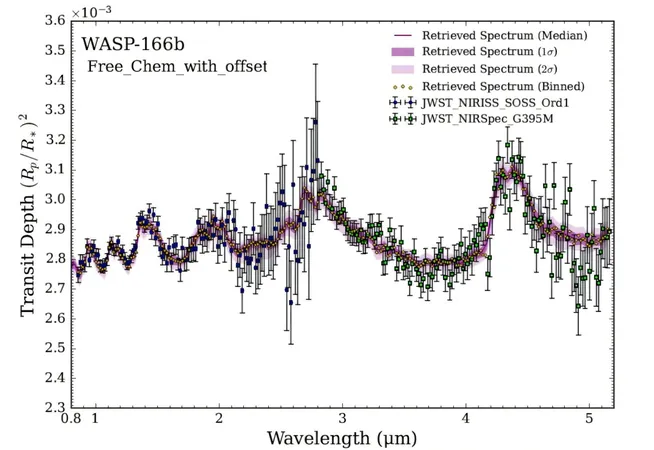
Astronomers Discover Water and Carbon Dioxide in the Atmosphere of WASP-166 b, a Hot Super-Neptune Exoplanet!
2025-01-09
Author: Ming
Groundbreaking Discoveries with JWST
In a groundbreaking study, astronomers using the James Webb Space Telescope (JWST) have identified the presence of water and carbon dioxide in the atmosphere of a hot super-Neptune exoplanet known as WASP-166 b. This exciting discovery, detailed in their report released on December 31, showcases the potential for understanding the molecular makeup of distant worlds.
WASP-166 b: An Impressive Exoplanet
WASP-166 b is an impressive specimen in the cosmos, measuring about seven times the size of Earth and boasting a mass that is 32 times greater. It orbits its star in close proximity, completing a full orbit every 5.44 days and situated roughly 0.067 astronomical units (AU) from its host star. The exoplanet's high equilibrium temperature, estimated at around 1,270 Kelvin, categorizes it among the elusive “hot Neptune desert,” an area of space that has very few planets with characteristics similar to these high-insolation, intermediate-radius worlds.
Star Characteristics
The star that gives life to WASP-166 b is located approximately 368 light-years away in the constellation of Corona Borealis. Designated as an F9V type star, it is about 20% larger and more massive than our Sun, with an effective temperature of 6,050 Kelvin and an estimated age of 2.1 billion years.
Research Methodology
Lead researcher Andrew W. Mayo from San Francisco State University spearheaded the study, employing JWST's advanced Near Infrared Imager and Slitless Spectrograph (NIRISS) alongside its Near Infrared Camera (NIRCam) to delve deep into the atmospheric composition of WASP-166 b. The team captured two distinct transit observations: one using the NIRSpec instrument and another through the NIRISS SOSS.
Findings on Atmospheric Composition
Their findings revealed a significant presence of both water vapor and carbon dioxide in the planet’s atmosphere, dominating the spectrum data collected. In addition, the team made intriguing weak detections of ammonia and cloud deck pressure, suggesting a richer atmospheric composition than previously thought.
Additional Atmospheric Insights
The rest of WASP-166 b's atmosphere is hypothesized to mainly consist of helium and hydrogen, combined in a primordial solar ratio. Although searches for additional compounds such as carbon monoxide yielded no results, the researchers did observe a unique carbon to oxygen ratio of approximately 0.282, which is markedly lower than that of its host star (0.41) and the Sun (0.55), indicating significant atmospheric metallicity at around 1.57.
Conclusions and Future Work
Concluding their study, the authors proposed that these compositional results could be the result of planetesimal accretion, potentially followed by core erosion or photoevaporation processes. This research not only enhances our understanding of WASP-166 b but also opens the doors to better comprehend the atmospheric dynamics of similarly structured exoplanets.
Looking Ahead
Stay tuned as scientists continue to unlock the secrets of our universe, revealing the astonishing realities of exoplanetary atmospheres that challenge everything we think we know about planetary formation and evolution!

 Brasil (PT)
Brasil (PT)
 Canada (EN)
Canada (EN)
 Chile (ES)
Chile (ES)
 Česko (CS)
Česko (CS)
 대한민국 (KO)
대한민국 (KO)
 España (ES)
España (ES)
 France (FR)
France (FR)
 Hong Kong (EN)
Hong Kong (EN)
 Italia (IT)
Italia (IT)
 日本 (JA)
日本 (JA)
 Magyarország (HU)
Magyarország (HU)
 Norge (NO)
Norge (NO)
 Polska (PL)
Polska (PL)
 Schweiz (DE)
Schweiz (DE)
 Singapore (EN)
Singapore (EN)
 Sverige (SV)
Sverige (SV)
 Suomi (FI)
Suomi (FI)
 Türkiye (TR)
Türkiye (TR)
 الإمارات العربية المتحدة (AR)
الإمارات العربية المتحدة (AR)